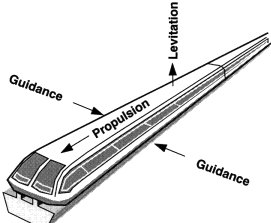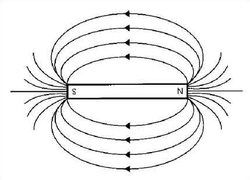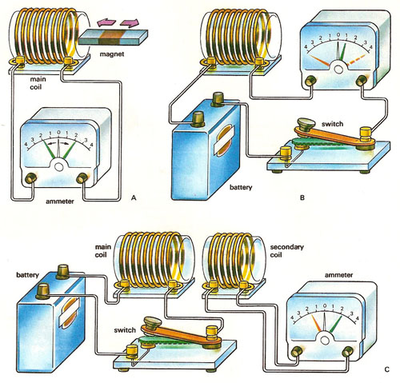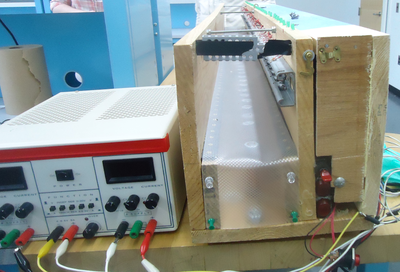Magnetic Levitation Competition
Objectives
The experimental objective of this lab is to design and assemble a maglev cart, following the specifications provided. Your cart must be able to fit into the maglev track and compete with the other groups of the section for the highest MDR (minimum design ratio) using the provided MDR equation.
Overview
Brief History of the origins of Magnetic Levitation
The name maglev is derived from the term Magnetic Levitation. The idea of magnetic levitation transportation was first introduced in the 1900s by Robert Goddard and Emile Bachelet. By the 1930s, Hermann Kemper was able to successfully develop a concept for the magnetic levitation using the principle of electromagnetic attraction.[1]
Principle of Electromagnetic Suspension (EMS)
Electromagnetic Suspension (EMS) is one of the two types of magnetic levitation. The magnetic levitation track from this experiment operates using the EMS concept. The concept of Electromagnetic Suspension operates primarily by inducing a current through the electromagnets to create a magnetic field. The EMS tracks require a large electrical power source to generate these magnetic fields from the electromagnets. Magnetic fields are created by the nature of how magnets function. Magnets contains two poles a north and a south pole. When magnets are brought together they create either an effect of attraction or repulsion depending on the poles that meet. If the opposite poles are brought together they attract each other while bringing together the same poles would create a repulsion effect. Magnetic Levitation Vehicles utilize this effect of attraction and repulsion to move along the track. Field lines are generated from this relationship between the North and South Pole in the magnets as shown in Figure 1. Electromagnets are unique in that they do not hold a permanent magnetic field by inducing a current through the electromagnets you could create a temporary magnetic field as shown in Figure 2. This temporary polarization allows the electromagnets to be turned on and off which contributes to the propulsion of the vehicle along the track. The magnetic levitation vehicles are pulled forward by the magnetic field created by the electromagnets.[2]
It is important to understand the concept of magnetic fields and how they function, in order to do so the following equation shows how the magnetic field for a solenoid, an electric conductor wound into a coil with multiple loops, is calculated. This applies to the magnetic levitation track because the track utilizes coils of solenoids to induce the current onto the electromagnets.
- is the magnetic field of the solenoid measured in Teslas ()
- is the magnetic constant for permeability in a vacuum which equals to
- is the number of turns in a loop per unit length of the solenoid coil
- is the induced current
The equation to calculate the magnetic field in a solenoid can also be expressed in terms of the number of loops and the length of the coil , shown in the following equation. In order to increase the magnetic field the number of turns in the coil of solenoid must be increased so in the magnetic levitation track the turns in the solenoids used has a large amount of turns.
Principle of Electrodynamic Suspension (EDS)
EDS is another type of magnetic levitation, where conductors are exposed to magnetic fields that vary with time. By using the EDS method the magnetic field generated for Magnetic Levitation vehicles, the electromagnets could be controlled by running a current through it similar to how the EMS principle works. [2]
Earnshaw's Theorem
Earnshaw's Theorem states that levitation over a consistent area of the magnetic field is not possible because of fluctuations that occur in the magnetic field. In other words, levitation is not in a state of equilibrium.[3]Due to this instability in the magnetic field additional modifications are often made to stabilize the Magnetic Levitation Vehicles, in the case of this experiment the walls are used to apply a normal force to keep the Magnetic Levitation cart from moving to the side.
Concepts of Magnetic Levitation
Magnetic Levitation is a type of transportation known for its ability of traveling at high speed without making physical contact with the track that the vehicle runs on. There are three primary components that make up the Magnetic Levitation. The first of the three components is levitation, the ability of the vehicle to stay afloat without making physical contact with the track that it rest on. The ability of the Magnetic Levitation vehicles to stay afloat comes from the use of electromagnets. Electromagnets are magnets that can create a temporary attraction to metallic objects. These electromagnets are used on the side of the railway as well as on the vehicle itself to create a repulsive interaction between the two which allows the vehicle to stay afloat. In order to prevent the vehicle from straying off the track a guidance system must be used, this is the second component used in magnetic levitation. The third component that makes up the Magnetic Levitation is the propulsion system; the function of electromagnets goes further than just keeping the vehicle floating it also contributes to its propulsion system as well. Since the electromagnets are magnets that can generate a temporary magnetic pull it could be used to pull the vehicle forward by simply turning the electromagnets on and off. The figure below shows a diagram of how each of the components contributes to the Magnetic Levitation system.[1]

This experiment employs a similar system which involves using system of LEDs (light-emitting diode) and photo-resistors which act as sensors to operate the electromagnets that are laid out on along the Magnetic Levitation track, which acts as the propulsion system. Along the side Magnetic Levitation track are magnets which helps keep the vehicle stay afloat as it travels through the track. The figure below shows the starting point on the Magnetic Levitation track used in this experiment.
Magnetic Levitation Trains and Conventional Trains
Magnetic Levitation transportation has many advantages over the conventional trains. Some of the advantages include; the ability of the magnetic levitation train to move at high speed without generating as much noise as the conventional trains and Magnetic Levitation trains use far less energy than conventional trains, which also contributes to the reduction of pollution. Magnetic Levitation trains also requires less maintenance compared to conventional trains which means once it is implemented into the transportation system the overall cost will be reduced. However due to the fact that the conventional train tracks are not suitable for Magnetic Levitation vehicles it is very expensive to replace the existing conventional rails. Another disadvantage of Magnetic Levitation trains is that electromagnets require a very strong magnetic field, which can only be achieved by constantly extracting a lot of energy from its energy source.[4]
Competition Rules
The competition rules must be followed at all times during the experiment. Violation of any of these rules listed will result in the disqualification of your team.
- The TA must approve your design before you are allowed to
- All the materials you use in your design must be purchased, and are non-refundable.
- The maglev cart must fit into the maglev track and may be no more than 11.5cm wide and must include the flag piece included in the maglev Lego kit.
- You may conduct up to three trials and the best ratio of the three trials will be taken.
- A TA must be present to oversee your trial or the results of that trial will become invalid.
- ALL Magnetic components must be returned at the end of the experiment or your grade for this lab may be jeopardized.
Scoring
The results of each trial in this lab will be calculated using the following equation, the group to achieve the highest ratio wins the competition.
- is the distance between the start of the track to LED 20 which is 31 cm if the cart reaches LED 20, otherwise it is 0 cm
- is the time elapsed as the cart travels from the start of the track to LED 20. If the cart doesn't reach LED 20,
- is the distance between LED 20 to LED 40 which is 31 cm if the cart reaches LED 40, otherwise it is 0 cm
- is the time elapsed as the cart travels from LED 20 to LED 40. If the cart doesn't reach LED 40,
Your Assignment
Individual Lab Report
Follow the lab report guidelines laid out in the page called Specifications for Writing Your Lab Reports in the Technical Communication section of this manual. As you write, the following discussion points should be addressed in the appropriate section of your lab report:
- Describe the rules of the competition in your introduction. What consequences did the rules have for your design decisions? Use the appropriate equations in your answer.
- Explain how electromagnets work.
- Explain the concepts of the Magnetic Levitation vehicles.
- Discuss the advantages and disadvantages of the maglev.
- Describe your maglev cart's design and explain the choices you made in your design.
- Discuss minimal design. Did you use all the materials you purchased? Describe the importance of minimal design and explain how you employed it in your design.
- Describe how your design succeeded or failed. What choices could you have made to improve your final standing in the competition?
- Discuss how you would improve the competition ratio.
Remember: Lab notes must be taken. Experimental details are easily forgotten unless written down. EG1004 Lab Notes Paper can be downloaded and printed from the EG1004 Website. Use the lab notes to write the Procedure section of the lab report. At the end of each lab, a TA will scan the lab notes and upload them to the Lab Documents section of the EG1004 Website. One point of extra credit is awarded if the lab notes are attached at the end of the lab report. Keeping careful notes is an essential component of all scientific practice.
PowerPoint Presentation
Follow the presentation guidelines laid out in the EG1004 Lab Presentation Format section of this manual. When you are preparing your presentation, consider the following points:
- Since one term in the competition ratio is cost, present the cost of your vehicle. Use the page How to Show Cost Data in Presentations for instructions on how to do this.
- Explains the concepts utilized by the Magnetic Levitation Track.
- Discuss minimal design. Did you use all the materials you purchased? Describe the importance of minimal design and explain how you employed it in your design.
- Describe how your design succeeded or failed. What choices could you have made to improve your final standing in the competition?
- Discuss how you would improve the competition ratio.
Materials and Equipment
- Center magnet, type 1: $1.00 (maximum one)
- Center magnet, type 2: $1.50 (maximum one)
- Outer magnets (custom): $0.75/each
- Long magnets (3/4" x 3/8" x 1/16" thick): $0.50/each
- Square magnets (3/8" x 3/8" x 1/8" thick): $0.25/each
- Bearings: $0.25/each
- LEGO kit and pieces: free
Procedure
- Brainstorm about possible designs for your maglev cart.
- Sketch your design on paper.
- Assemble your design using the Maglev Lego Kit provided.
- Obtain the magnetic parts from a TA after your design has been approved.
- Practice runs are allowed to make sure your cart works before the actual trials begins
- At the presence of a TA you could conduct your actual trials for your MDR (a total of three trials)
- Once the cart has come to a stop on the track the ratio will be calculated for the completed checkpoints (n) on the track.
- After three trials are completed you have completed the lab and the best trial will be taken to designate the winners of this competition lab.
- Before leaving the room, disassemble your carts and place the parts back into their corresponding sections in the kit. ALL magnetic components must be returned to your TA before you are allowed to leave.
References
- ^ a b Bellis, Mary. "The History of Railroad Innovations." About.com Inventors. Accessed 24 January 2012 from http://inventors.about.com/library/inventors/blrailroad.htm#advanced.
- ^ a b Brain, Marshall, and Lance Looper. 01 April 2000. "How Electromagnets Work." HowStuffWorks.com. Accessed 24 January 2012 from http://science.howstuffworks.com/electromagnet.htm.
- ^ Gibbs, Philips and Geim, Andre. March 1997. "Is Magnetic Levitation Possible?" Usenet Physics FAQ. Accessed 26 January 2012 from http://math.ucr.edu/home/baez/physics/General/Levitation/levitation.html.
- ^ a b Bonsor, Kevin. 13 October 2000. "How Maglev Trains Work." HowStuffWorks.com. Accessed 24 January 2012 from http://science.howstuffworks.com/transport/engines-equipment/maglev-train.htm.



 is the magnetic field of the solenoid measured in Teslas (
is the magnetic field of the solenoid measured in Teslas ( )
) is the magnetic constant for permeability in a vacuum which equals to
is the magnetic constant for permeability in a vacuum which equals to 
 is the number of turns in a loop per unit length of the solenoid coil
is the number of turns in a loop per unit length of the solenoid coil is the induced current
is the induced current and the length of the coil
and the length of the coil  , shown in the following equation. In order to increase the magnetic field the number of turns in the coil of solenoid must be increased so in the magnetic levitation track the turns in the solenoids used has a large amount of turns.
, shown in the following equation. In order to increase the magnetic field the number of turns in the coil of solenoid must be increased so in the magnetic levitation track the turns in the solenoids used has a large amount of turns.


![{\displaystyle MDR={\frac {m[{\text{g}}]}{cost[\$]}}\left({\frac {d_{01}[{\text{cm}}]}{\Delta t_{01}[{\text{s}}]}}+{\frac {d_{12}[{\text{cm}}]}{\Delta t_{12}[{\text{s}}]}}\right)\,}](https://wikimedia.org/api/rest_v1/media/math/render/png/9230f398194b74e3b59977e22082c6a07bbac290)
 is the distance between the start of the track to LED 20 which is 31 cm if the cart reaches LED 20, otherwise it is 0 cm
is the distance between the start of the track to LED 20 which is 31 cm if the cart reaches LED 20, otherwise it is 0 cm is the time elapsed as the cart travels from the start of the track to LED 20. If the cart doesn't reach LED 20,
is the time elapsed as the cart travels from the start of the track to LED 20. If the cart doesn't reach LED 20, 
 is the distance between LED 20 to LED 40 which is 31 cm if the cart reaches LED 40, otherwise it is 0 cm
is the distance between LED 20 to LED 40 which is 31 cm if the cart reaches LED 40, otherwise it is 0 cm is the time elapsed as the cart travels from LED 20 to LED 40. If the cart doesn't reach LED 40,
is the time elapsed as the cart travels from LED 20 to LED 40. If the cart doesn't reach LED 40, 